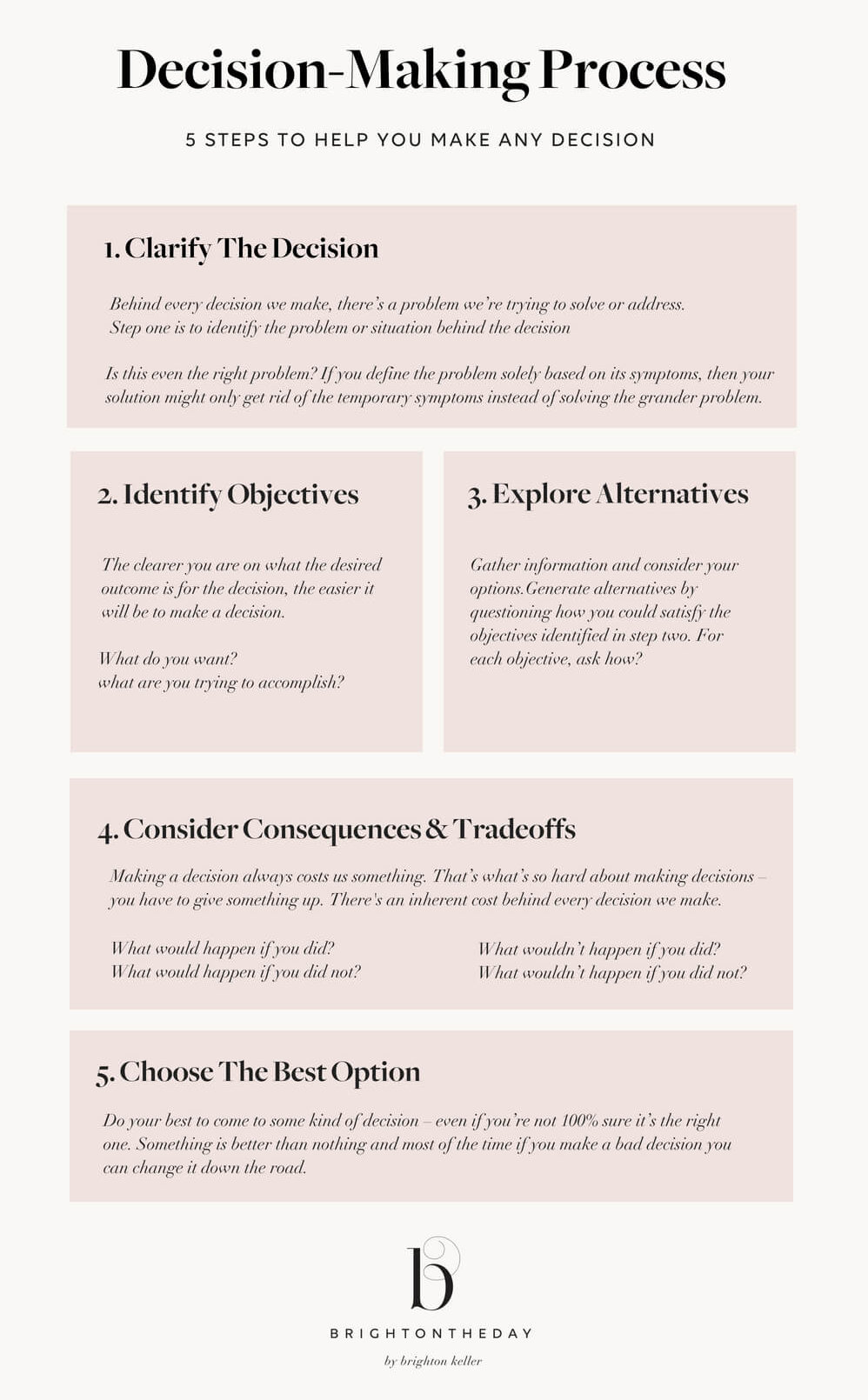Self - August 14, 2018
How To Be Better At Making Decisions
Over the years of BTD, it is a pretty well-documented fact that making decisions is NOT my strong suit. I don’t know if it’s the fear of missing out or playing too many ‘what if’ scenarios in my head, but whatever the case may be, when it comes to “efficient” decision-making: I cringe. The net result of this cringe-induced paralysis? I don’t make a decision at all. Instead, I end up loitering in this self-inflicted, wishy-washy grey area – feeling overwhelmed and stuck.
I’ve been this way for as long as I can remember. Some people are just naturally better at being more decisive, and I’m just not one of them. In the moments that I’m honest with myself, it’s clear this trend is affecting every facet of my life. From choosing where to go to college to narrowing down blog topic ideas, or even something as small as selecting a photo to post on Instagram on any given Tuesday morning. In short, what I’m saying is that I suck at making decisions, and I’m starting to see the consequences. I think it’s fully dawned on me that ‘not making a decision’ is, in fact, making a decision. Except with no ownership or advocacy. And you know what guys? I’m tired of it!
But, why am I like this? Recently, I’ve been trying to wrap my head around it – or at least put it into words. Why is it so hard for me to make a decision? Is there something else going on that I’m not consciously aware of? Of course, every decision is different and there are different factors at play, but still, there are commonalities/underlying principles/strategies we can all learn from.
I’m not an expert on this as y’all already know but I also think it might be helpful to hear about how to be more decisive from someone who isn’t naturally decisive.
Tips For The Decision-Making Process
Whether I’m deciding how I’ll spend my Saturday morning, choosing a direction for my business or anything in between, there are a few things that help me get through the decision-making process that you might find helpful and encouraging:
1. Clarify The Decision
This might sound obvious, but the first step in making a good decision is clarifying the problem or question being addressed, and why. Sometimes the reason it feels impossible to make a decision is that we haven’t really thought it through.
Why Are We Here? Why are we making a decision? Behind every decision we make, there’s a problem we’re trying to solve or address. And if we’re not clear on exactly what that problem or issue is, then we’re missing part of the picture. You need to define your problem and get a clear understanding of the issue your decision is addressing.
Our understanding or definition of the “problem” dictates how we perceive the decision at hand. The better defined your problem is, the easier it will be to solve it. Likewise, understanding the problem sets the stage to clarify the decision which in turn affects all other aspects of the decision-making process. Gaining a clear and common understanding of the question is often harder than it seems, but is key to working on the answer.
Is this even the right problem? Consider the problem you just defined. Is this the real issue or is this problem just a symptom of something deeper? If you define the problem solely based on its symptoms, then your solution might only get rid of the temporary symptoms instead of solving the grander problem.
2. Identify Objectives
What do you actually want? What are you trying to accomplish with your decision? In order to make a good decision, you need to know what your end game is. This will inevitably point you back to the problem that you’re trying to solve, which is why it’s so important to get crystal clear on defining the problem first.
Whether you realize it or not, your objectives will guide and influence your decision-making process and ultimately your decision. The clearer you are on what the desired outcome is for the decision, the easier it will be to make a decision. Clarifying your objectives and spending time thinking about them will also help you get a better understanding of what you actually want.
If I’m near pen and paper, I do a braindump and get it all out of my brain. It always helps me see the options better and figure out what’s really going on. Something that helps get my brain going is to ask why over and over again. I try not to make any assumptions or skip any steps in my thought process. But instead, I try to think like a child, asking why repeatedly in order to peel back the thought layers.
3. Explore The Alternatives
This is the part where you gather information. You want to make sure you’re looking at the full picture. It would be pointless to make a decision without thoroughly considering the choices and alternatives to choose between. And a lot of the time, our choices aren’t as black and white as they seem at first glance.
When it comes to decisions, most of us have been taught to think of things in terms of ‘this or that’. But usually, you can find a way to turn an either/or situation into a both/and situation. Or you can see options C, D, E and F that you hadn’t even considered before.
Putting pen to paper helps in a huge way and I think it’s when I skip this step that I feel the most trapped. You need to let yourself and your thoughts stretch a bit here – it’ll be a good mental exercise to get you thinking outside the box. A good way to generate alternatives is to take your objectives you defined above and ask “how?” for each of them. Ask yourself how you could potentially meet or satisfy said objective?
It’s also really important to recognize what will happen if you don’t make a decision. I’ve found that when I’m faced with a really hard decision, it’s always tempting not to make any decision at all; that way, I can’t make the wrong one.
But here’s the thing: not making a decision is, in fact, a decision. So don’t let yourself get stuck in the deliberation stage. Yes, you want to consider alternatives and seek new information but at the end of the day, a decision must be made. And you’re better off consciously making the decision than letting life or someone else decide it for you.
4. Consider Consequences & Tradeoffs
Now that you’ve got your options clearly defined, let’s play the tape forward. Spend some time thinking through what the consequences of each scenario would be. It might seem obvious, but really think through what would actually happen if you were to choose option A or option B etc.? How will things be different? How does this outcome relate back to the objective you set earlier on in the decision-making process?
Another thinking framework I use during this step is to Imagine the worst-case scenario. I do this when I know what I want to do but I’m too scared to do it. It always helps me realize that the worst-case scenario isn’t actually that bad or even probable. And it gives me the courage to go for it. The four questions of Cartesian Logic are perfect for this and help me think through how things will play out depending on which option I choose. If you need some help here, journal through these questions:
What would happen if you did?
What would happen if you did not?
What wouldn’t happen if you did?
What wouldn’t happen if you did not?
In addition to consequences (both good and bad) that will result from the decision we make, there are also tradeoffs. Tradeoffs are the outcomes we give up by deciding one choice over another (or others). By making a decision to walk one way, we are inherently giving up the opportunity to walk another way. We might not always be aware of it, but making a decision always costs us something. That’s what’s so hard about making decisions – is that you have to give something up. You have to wholeheartedly choose one path and give up the other(s).
5. Choose The Best Option
After you’ve gone through all the steps above, choosing the best option should at least be a little easier to think through. My advice is to weigh your options based on the objectives of your decision, within the context of your particular issue/problem, and in alignment with what you see to be most important.
It’s not always easy to know what the best option is, but you can at least feel confident in the fact that you’re making an informed decision.
Do your best to come to some kind of decision – even if you’re not 100% sure it’s the right one. Something is better than nothing and most of the time if you make a bad decision you can change it down the road. And not only that, some of your ‘worst’ decisions will lead you to the most beautiful, unexpected things in life – so there isn’t really a wrong choice when you think about it.
*
PS: Remember To Put Things In Perspective
When I think about these decision-making “ruts” I get in, the thing that stands out to me is the suffocating feeling of the pressure to make the right choices. The feeling that if I mess up a decision, the whole world will go to pieces. I know that sounds dramatic but I’m sure y’all can relate.
When I dig deeper into these emotions, I realize that this is a control issue. By carrying this million-ton weight on my shoulders, I’m really making a statement. I’m telling myself, those around me and God that I AM THE ONE who holds the control and power. That the decisions I make are THE determining factor for the outcome.
This is dangerous territory. When we give ourselves so much credit for every decision and choice we make, we are turning a blind eye to God’s sovereignty and power in our lives. God’s sovereignty means “supreme power and authority”. It means that I can make all the right plans and decisions, and His plan will prevail. Even more importantly, it means that I can make all the WRONG decisions, and His plan will prevail.
Proverbs 16:9 says that we can make all the plans we want, but that our plans won’t determine outcomes. God determines our steps. HE holds the true power in our lives. If we are seeking His plans for our lives and making prayerful decisions, we cannot mess things up. Let that sink in and decision fatigue will disappear because the pressure is finally off. We can shake off the “rut” we are in because we don’t have to remain frozen in fear. We feel relief and freedom to make the best decisions we can, and leave the rest up to God.
*
What Do You Think?
Did y’all find this helpful?
Please let me know in the comments because I’m still feeling like a bit of a weirdo for finding this stuff so interesting. Tell me I’m not alone k??
Brighton Your Day
Get exclusive content, sale items, and lots of fun stuff, straight to your inbox!




Share Story:
Join the Conversation
0 / View All